Advertisement
Grab your lab coat. Let's get started
Welcome!
Welcome!
Create an account below to get 6 C&EN articles per month, receive newsletters and more - all free.
It seems this is your first time logging in online. Please enter the following information to continue.
As an ACS member you automatically get access to this site. All we need is few more details to create your reading experience.
Not you? Sign in with a different account.
Not you? Sign in with a different account.
ERROR 1
ERROR 1
ERROR 2
ERROR 2
ERROR 2
ERROR 2
ERROR 2
Password and Confirm password must match.
If you have an ACS member number, please enter it here so we can link this account to your membership. (optional)
ERROR 2
ACS values your privacy. By submitting your information, you are gaining access to C&EN and subscribing to our weekly newsletter. We use the information you provide to make your reading experience better, and we will never sell your data to third party members.
Environment
2008 R&D Budget Holds No Surprises
Bush's proposed budget continues last year's programs, offers meager gains
by Lois R. Ember, David J. Hanson, Bette Hileman, Cheryl Hogue, Jeff Johnson, and Susan R. Morrissey
February 19, 2007
| A version of this story appeared in
Volume 85, Issue 8
ON THE FACE OF IT, the research and development budget for fiscal 2008 proposed by President George W. Bush on Feb. 5 is simple. He asked for increases in spending at the same agencies for which he had proposed increases in 2007, and he made cuts in R&D funding at the same agencies he cut last year. Unlike last year, when Bush proposed the American Competitiveness Initiative to boost physical science research and science education, this year he offered no new science initiatives in this budget.
This means that R&D programs at the Department of Energy, the National Institute of Standards & Technology, and the National Science Foundation should get more money in the next fiscal year, but research at the Department of Agriculture, the Environmental Protection Agency, and even the Department of Defense could suffer cuts.
The picture is a lot more complicated, mostly because Congress has not completed the budget for fiscal 2007. Without access to 2007 budget figures for making comparisons, it's impossible to understand just where next year's R&D budget actually may be higher or lower.
The White House Office of Management & Budget (OMB) and the various R&D agencies have provided budget numbers for this year, but they are going to change. The numbers given are either those approved for fiscal 2007 or estimates by the particular agency of the funding level it anticipates.
Congress already has indicated that some agencies will get a little more than Bush proposed for fiscal 2007, and there is a strong movement in Congress to eliminate member-initiated research projects, or earmarks. These can add up to millions of dollars in some agency budgets.
Overall, Bush proposed spending $143 billion in federal funds for R&D in fiscal 2008. This is a small increase, about 2.5%, above the 2007 estimated budget. Of this total, the Administration says $28 billion will be spent on basic research, more than half of which will be by the National Institutes of Health. The bulk of the R&D funds, $83 billion, goes to development projects, almost all of which are in the Defense Department.
The following review of proposed R&D spending at the federal agencies comes with some caveats. The numbers are given mostly as budget obligations, that is, the money that agencies can contract to spend during the fiscal year. This may be more or less than the agencies actually spend, or outlay, during the year.
Also, the federal budget is a very complicated document with various ways of adding up programs and totals. As a result, sometimes agency or department figures and totals from OMB are not the same and can be published in different places in different amounts. These variations are usually small and reflect alternative methods of dividing up funds.
NSF. In a continued effort to improve America's competitiveness, NSF is slated to grow nearly 7% over the 2007 proposed level, for a total budget of $6.4 billion. The bulk of this increase will go toward raising Research & Related Activities funding, which is set to see a 7.7% jump to $5.1 billion.
The increases reported by NSF in its 2008 proposed budget are calculated using the Administration's 2007 request, which has yet to be appropriated. The foundation, however, expects to receive its full 2007 request for its Research & Related Activities portion of the budget based on the joint resolution passed in the House and awaiting Senate approval.
NSF will use its growing funds to support some new initiatives as well as some continuing priorities. One new initiative focuses on developing new computationally based discovery concepts and tools for examining complex, data-rich, and interacting systems. The initiative, Cyber-Enabled Discovery & Innovation (CDI), is set to receive $52 million under the proposed budget.
The foundation will also make a new investment of $17 million in ocean research. As part of the national Ocean Research Priorities Plan, NSF will fund four areas, namely, the complex dynamics that control and regulate marine ecosystem processes, variability of the Atlantic Meridional Overturning Circulation in the Atlantic Ocean, the development of new sensors for marine ecosystems, and the response of coastal ecosystems to natural events and human-influenced processes.
Climate research also will get a boost in NSF's 2008 budget, because NSF will lead the U.S. in its International Polar Year activities. The proposed $59 million will support efforts to outline environmental changes in the polar regions and study how life adapts to and survives in the polar dark.
Other budget highlights include nearly $33 million to start preparations for the Advanced Laser Interferometer Gravitational Wave Observatory, an instrument with improved sensitivity for detecting gravitational waves. NSF also will continue its support of nanotechnology by increasing its investment by $17 million in 2008 to a total of $390 million.
The 2008 budget also will allow NSF to increase support for its Experimental Program to Stimulate Competitive Research—or EPSCoR—by 7% to $107 million. To help prepare the 21st-century workforce, the foundation will invest an additional $9 million to fund 200 more graduate students under its Graduate Research Fellowship Program in 2008.
Divisions within the Math & Physical Sciences Directorate (MPS) are set to see gains, with the total request for MPS at $1.3 billion, up 9% from the 2007 request. The largest dollar gain is slated for the Materials Research Division, which will grow by $25 million to $283 million. The Chemistry Division is set to receive the biggest percent gain at 10.5%, bringing its total to $211 million.
In addition to being at the heart of the efforts to improve American competitiveness, MPS will focus its efforts on several areas. These include physical sciences at the nanoscale, sustainability, and exploring the physics of the universe. MPS also will be responsible for a $10 million share of the foundation's CDI initiative.
Along with the 2008 budget, MPS also announced its plans to start a pilot American Competitiveness Initiative Fellows program in 2008. The program will link undergraduate, graduate, postdoctoral, and early- to midcareer faculty research experiences.
NIH. The proposed 2008 budget for NIH provides only a slight increase for the agency. On the basis of the 2007 funding levels passed by the House in joint resolution, NIH stands to grow by 0.8% in 2008 to $28.8 billion. This slow growth marks the fifth straight year that agency funding has not kept pace with biomedical inflation, which is estimated to be 3.7% for 2007.
The 27 centers and institutes within NIH are requesting less than 1% changes from the estimated values for 2007, with the exception of the National Institute of Allergy & Infectious Diseases. NIAID is set to see a 4.8% jump in its budget to $4.6 billion, due in large part to a $201 million increase to support the President's commitment to the Global Fund for HIV/AIDS, Tuberculosis & Malaria.
NIH will continue to fund its cross-agency Roadmap initiatives. The 2008 budget provides a 10% growth in support for this program for a total investment of $486 million.
To ensure that the pipeline of new investigators and researchers remains strong, NIH proposes to increase its funding of the Pathway to Independence program by $16 million to a total of $31 million. The budget proposal would hold training and research stipends at 2007 estimated levels, but it would only allow for 17,520 full-time training positions, a cut of 56 positions.
Support for research project grants would increase under the requested 2008 budget. The budget would provide $3.6 billion to fund 10,188 competing grants, which is up by 566 over the estimated number funded in 2007. The average cost of these grants will remain at the 2007 levels. Although the number of competing grants will grow, the budget will not provide for any inflationary increases for direct, recurring costs in noncompetitive project grants.
DEFENSE. Defense is one of the two departments in the government that received a fiscal 2007 appropriation last year. The other is the Department of Homeland Security (DHS). The total proposed R&D funding at DOD is $75 billion, which is a 1% decrease from the 2007 budget.
Describing the proposed budget for R&D at the Defense Department is a two-pronged problem. The research portion of the budget, both basic and applied, is down considerably from last year, but the development and testing programs are scheduled to receive huge increases. This growing split shows the effects of Administration priorities favoring short-term programs in support of current military conflicts versus long-term research activities.
Proposed funding for basic and applied research, which totals about $6 billion, would be cut by 16% from last year's appropriation. One of the Administration's complaints has been that the department funds a lot of medical research, especially cancer research, and this is an area in which funding is usually cut but later restored by congressional appropriators.
There are also reductions in the University Research Initiative, a program supported by the three military services that award competitive basic grants to university researchers. Funding for this program would fall 15%, to $246 million under the proposed budget. The department's National Defense Education Program, a relatively new effort to encourage U.S. students to get degrees in science and engineering, is slated for an increase, from $19 million to $44 million in 2008.
Holding its own is the Defense Advanced Research Projects Agency, or DARPA, which is scheduled to receive the same funding as for 2007, about $3.1 billion.
The major weapons development programs get the lion's share of the Defense R&D funding. At almost $68 billion, the development programs would rise more than 5% above 2007. Gaining much of that increase is the Air Force, which will receive an additional $3.5 billion next year for work on major projects such as the Joint Strike Fighter and a new tanker refueling aircraft.
HOMELAND SECURITY. In his fiscal 2008 proposal, the President requests $61.1 billion for homeland security funding for 31 government agencies and departments, an increase of 4.8% from last year. Five departments?DHS, Defense, Health & Human Services, Justice, and Energy?account for 93% of the total funding for homeland security, and DHS is receiving the bulk. Still, the $34.3 billion for DHS in fiscal 2008 is actually a decline from about $38 billion in fiscal 2007.
The R&D portion of DHS's budget also presents a less than sanguine picture. According to American Association for the Advancement of Science budget maven Kei Koizumi, DHS's total R&D budget will decline 1.5% in fiscal 2008.
Two main components make up the agency's R&D portfolio: the Science & Technology Directorate (S&T) and the Domestic Nuclear Detection Office (DNDO). In the fiscal 2008 budget, DNDO receives $257 million, up 19% from fiscal 2007. S&T, however, drops 7.9%, from $713 million this year to $656 million for fiscal 2008.
"Fiscal 2008 is a continuation of the trends seen in fiscal 2007," Koizumi says. As he explains, that means "a continuing expansion of the Radiation-Nuclear Countermeasure portfolio, which was transferred to DNDO this year, and continuing cuts to the rest of the R&D activities within S&T."
Advertisement
For example, the Chemical-Biological Countermeasures portfolio within S&T declines by 27%, from $314 million in fiscal 2007 to $229 million next year. The University Programs portfolio also drops precipitously, by more than 20%, from $49 million this year to $39 million next year.
Considering the concern over the threat of terrorists using improvised explosive devices in the U.S. as insurgents have with those infamous roadside bombs in Iraq, it's surprising that the Explosives Countermeasures portfolio within S&T is slashed by nearly 40% in fiscal 2008. This decline is part of a pattern since fiscal 2006, when S&T received $262 million for explosives countermeasure research, which then dropped 60% to $105 million in fiscal 2007. For next year, the Administration requests only $64 million.
The Administration "is reporting an expansion of basic and applied research and a contraction of the development portion" of DHS's R&D budget, Koizumi says. "Expansion primarily comes from the DNDO portfolio, which is very research oriented," he explains. "S&T is more development focused." Overall, DHS's basic and applied research climbs nearly 7% in fiscal 2008, from $623 million this year to $665 million next year.
Also in the fiscal 2008 budget request, DHS is slated to receive $25 million to improve chemical plant security and to regulate security at chemical facilities. If appropriated by Congress, these funds will be used, in part, to assist facilities with vulnerability assessments.
The Department of Agriculture, in conjunction with DHS, is being allocated $539 million in fiscal 2008 to continue research efforts to counter threats to the nation's food and agricultural industries. EPA is receiving $69 million to support research in drinking water security and postterrorist incident decontamination.
The Administration continues to stress basic and applied research aimed at developing new medical countermeasures against chemical, biological, nuclear, and radiological threats and is requesting $1.9 billion for this area. The majority will go to support biodefense research sponsored by NIAID.
ENERGY. Department of Energy scientists will continue to see a steady rise in funding if Congress backs the Administration's budget proposal for 2008. Some will see a significant boost: R&D for nuclear energy, for instance, shows a $220 million jump, an increase of 63%, mostly to explore spent-fuel-reprocessing technologies.
DOE budget documents show increases for basic physical sciences as well. Some $4.4 billion of DOE's total $24.3 billion proposed budget would fund the Office of Science, DOE's basic science research office. The increase is 7.2% more than fiscal 2007 funding. However, these numbers could be misleading.
In its fiscal 2008 budget documents, DOE compares the 2008 proposal to Congress with the 2007 proposal, rather than an appropriated amount for 2007, which is usually the case. DOE has little choice because Congress has yet to enact a funding bill that would set a real DOE appropriation for fiscal 2007.
Undersecretary for Science Raymond L. Orbach warns that DOE's 2007 Office of Science appropriation could fall $305 million short of the Administration's 2007 proposal, depending on the level that congressional appropriation committees select in funding legislation, now pending before the Senate.
All that aside, for 2008, DOE's Office of Science—of which Orbach is director—is aiming high. Comparing 2008's proposal to 2006 actual appropriation, for example, the Office of Science is seeking a 21% boost over two years ago.
Orbach calls it a "wonderful budget" and singles out several proposed research areas, particularly highlighting the Administration's plan to increase the number of planned biofuels centers from two to three. The centers are intended to conduct basic research to find microbes and plant species that can be used to enhance ethanol and other biofuels production from cellulosic feedstocks. Each center would receive $25 million per year for five years, and the centers are to be located in existing universities, government laboratories, nonprofit organizations, and private companies. Orbach says the centers will be selected in the summer.
Overall, the DOE Office of Science proposal would allocate about $1.8 billion for facilities, such as accelerators, light sources, and other research centers; $2 billion to fund research activities; $160 million for the U.S. contribution to the international thermonuclear experimental reactor project, or ITER, a fusion power demonstration reactor under construction in France; and $400 million in program management.
About $284 million is directed to chemically related science programs, including funding for the office's five nanoscale research centers and its hydrogen and biomass research programs, as well as funding to support a broad range of user research facilities that are important to chemists.
Also proposed is a 20.7% boost for fossil energy research, compared with the 2007 budget request. Nearly all the fossil energy funding ($567 million) is directed to coal R&D ($427 million) as is almost the entire increase in fossil research funds proposed for 2008. More than $300 million of this is directed to develop systems to burn coal more cleanly, such as gasification technologies, and research to capture, control, and sequester carbon dioxide.
Some $568 million would fund research on nuclear power electricity-generating systems. This represents a 63% or $220 million increase over the Administration's request for 2007. Most ($395 million) is intended for the Global Nuclear Energy Partnership (GNEP). Last year, the Administration sought $250 million for GNEP. The new program has many advocates in Congress but also many critics.
GNEP is likely to face a thorough examination in Congress. At the first Senate hearing on the DOE budget, on Feb. 7, Energy & Natural Resources Committee Chairman Jeff Bingaman (D-N.M.) called GNEP "undefined" and said more information would be required of DOE before Congress would appropriate funds. GNEP research would focus on reprocessing technologies to reuse spent nuclear fuel in nuclear reactors. The U.S. has never engaged in reprocessing fuel for commercial reactors due to plutonium proliferation fears.
In other energy areas, energy efficiency and renewable energy R&D are slated for a 5.2% increase to $889 million. The majority ($213 million) would support hydrogen technology development, mostly for vehicular fuel cells and storage systems. Vehicle-related energy research would also get another $176 million for research on lighter materials, better batteries, and electric motors for hybrid and plug-in vehicles.
Biomass and bioenergy R&D would increase by 20% to $179 million, mostly to support construction of a biorefinery demonstration project. Like the biofuel centers, much of this research would support development of cellulosic feedstock for biofuels.
Looking at other renewable technologies, solar energy research funding remains at $148 million, nearly identical to this year's request; wind would receive an 8% reduction to $40 million; and building and lighting energy efficiency research gets an 11% boost to $86 million.
NASA. The Administration's proposed 2008 budget continues focusing the National Aeronautics & Space Administration's resources on returning humans to the moon in preparation for deeper space missions. The requested budget of $17.3 billion represents a 3.1% boost over the 2007 proposed budget.
Although the growth of NASA's 2008 budget is calculated against the 2007 requested budget, agency officials point out that under the House-passed joint resolution, the actual 2007 funding levels would be $545 million less than requested. It is unclear how the lower appropriation would affect 2007 activities.
As proposed, the 2008 budget does not include any strategic changes for the agency. It does prioritize crew and cargo vehicle development and space shuttle flights to complete the International Space Station (ISS), while slowly increasing its science investments.
The development of the crew and cargo vehicles falls under the Exploration Systems Directorate, which will see an increase under the 2008 proposed budget to $3.9 billion, up 5.5% from the 2007 request. From this account, $951 million will go to support the design and development of a new crew vehicle and $1.2 billion will be used to support the development of a new type of rocket to launch the new crew vehicle.
Funds will also be used to support a key lunar orbiter and satellite mission that will help NASA gather information necessary to refine its missions to the moon.
The Space Operations budget, which includes the shuttle and ISS programs, will also grow under the 2008 proposed budget by 11.2% to $6.8 billion. NASA will direct $4.0 billion—or 0.3% less than the 2007 request—to support the space shuttle and the four or five planned shuttle missions for 2008. Support for ISS operation and assembly, however, will increase by 27.0% to $2.2 billion under the 2008 request.
The 2008 proposed budget is not as kind to the Science Directorate. Under the proposed budget, science programs would grow by only 0.9% from the 2007 request. The programs highlighted by the agency include the launch of several satellites in 2008 to study earth science, astrophysics, and heliophysics. Funds will also be used to upgrade the Hubble Space Telescope during a shuttle mission scheduled for 2008.
COMMERCE. The primary science agencies within the Department of Commerce—NIST and the National Oceanic & Atmospheric Administration (NOAA)—are both slated for increases under the 2008 proposed budget as compared with the proposed 2007 budget requests.
Advertisement
NIST is set to grow by 10.2% to $641 million in 2008 due in large part to the agency's key role in the American Competitiveness Initiative. The 2008 budget would give laboratory research an additional $33 million, for a total of $493 million. The increase will be used to continue support of a dozen initiatives from 2007 and to start five new ones.
The five initiatives include enabling nanotechnology from discovery to manufacture, which will get $6 million in new funding; measurements and standards for the climate-change science program, which will get an additional $5 million; enabling innovation through quantum science, which will get an additional $4 million; disaster-resilient structures and communities, which will get an additional $4 million; and the national earthquake hazards reduction program, which will get an additional $3 million.
NIST will also spend half of its $94 million Construction & Research Facilities budget request on construction of a new facility on its Boulder, Colo., campus and continued improvements to its Center for Neutron Research in its main Gaithersburg, Md., campus.
For NOAA, the 2008 budget request raises its funding level by 3.4% to $3.8 billion. The agency will direct its 2008 budget toward supporting the President's U.S. Ocean Action Plan, developing sustainable uses of ocean resources, improving weather forecasts, and maintaining facilities and other operations. The budget will also provide additional funds for advanced ocean science and research (including support for the national Ocean Research Priorities Plan), as well as for climate research.
AGRICULTURE. As it did in 2006, the Administration has proposed a large reduction in USDA R&D funding. But the figures are extremely uncertain because Congress still has not passed a final budget for fiscal 2007. USDA's research budget would fall 12.0% from the volatile $2.7 billion estimate for fiscal 2007 to just under $2.4 billion for 2008. In 2008, R&D will focus on three priorities: expanding domestic market opportunities, increasing the efficiency of agricultural production and marketing systems, and reducing the number and severity of agricultural pest and disease outbreaks.
Among USDA's R&D agencies, the Agricultural Research Service (ARS) and the Cooperative State Research Education & Extension Service (CSREES) would suffer almost equal funding cuts. The budget for ARS would fall $160 million, or 13.2%, from $1.22 billion to $1.1 billion. Most of the savings at ARS are achieved through eliminating earmarks worth $141 million and vastly reduced funding for new facilities.
Rather than spending $140 million on new facilities, $16 million would be used in 2008 to plan and design a biocontainment facility in Athens, Ga., where research will be conducted on diseases such as avian influenza and West Nile virus. In addition, the budget includes an increase of $11 million for research on converting crops and crop residues to biofuels.
The ARS budget also seeks an increase of $15.6 million for research on mad cow disease and chronic wasting disease, as well as avian influenza. An additional $3.9 million is requested for combating emerging rust diseases of grain and soybeans. The budget includes an additional $7 million to understand the dietary patterns that contribute to obesity in low-income and minority populations, especially children.
The budget for CSREES would decline by $144 million, or 12.1%, to $1.0 billion in 2008. Most of the cuts are accomplished by zeroing out earmarks worth $157 million in the 2007 budget.
At CSREES, the National Research Initiative—USDA's primary competitive research grants program—would get an increase of $68 million to $257 million. This includes $19 million for research on bio-based fuels and $42 million for research on food safety, water quality, transition to organic agriculture, and pest management.
The request sought for Forest & Rangeland Research is $263 million, a decline of 6.1% from the $280 million in 2007. The goal of this research is to develop technologies to enhance the economic and environmental values of all the nation's forests.
It remains to be seen whether Congress will restore many of the earmarks zeroed out in USDA's proposed budget. "The whole idea here of defunding earmarks is to bring some transparency to the process," Agriculture Secretary Mike Johanns says. Congress is committed to cutting way back on the earmarks, he adds.
EPA. For 2008, Bush is proposing to trim EPA's overall budget by nearly 1.5% to $7.2 billion, down from $7.3 billion requested for fiscal 2007. The science and technology program at EPA, however, would be cut 4.2% in 2008, declining to $755 million from the $788 million Bush requested for fiscal 2007.
"We have had to make adjustments," says George M. Gray, EPA assistant administrator for research and development and science adviser to the agency's administrator.
Research on protecting human health and ecosystems would suffer a 10% cut, down from $161 million to $145 million. Gray says some of this reduction would come from a decrease in extramural funding for the agency's Environmental Monitoring & Assessment Program. In-house work on this program would continue, he adds.
Funding for EPA research on endocrine disrupters would see a modest increase for 2007, from $9 million to $10 million.
According to EPA budget documents, the agency's research budget for pesticides and toxic chemicals would decline from the $26 million requested for 2007 to less than $25 million in 2008. High-priority research in this area involves perfluoroalkyl chemicals, those documents say, including research on the toxicity of these compounds as well as the potential for perfluorinated telomers to degrade into perfluorooctanoic acid (PFOA). This substance, which is also used in the manufacture of nonstick cookware, is highly persistent in the environment and is found at low levels in the blood of much of the population. EPA's science advisers have said PFOA should be classified as a "likely" carcinogen in humans.
In addition, the budget documents say the agency will begin development of a computational model of the liver in 2008. EPA says this will improve understanding of the factors that make people or wildlife susceptible to toxicity from exposure to chemicals.
Gray says EPA research priorities in 2008 include improving risk assessments and the study of nanomaterials for their application in environmental cleanup and their implications to ecosystems and human health. EPA's slice of the National Nanotechnology Initiative would grow from $9 million proposed for 2007 to $10 million in 2008, according to budget documents.
THE BUDGET PROCESS. The fiscal 2008 budget now goes to the House and Senate Appropriations Committees, where it is divided into several appropriations bills. Hearings will be held on each by various committees, and legislation will emerge that sets the levels of spending for all federal departments and agencies.
The numbers approved by Congress may be very different from those originally proposed by the Administration, but historically, R&D has not been radically changed. The process is supposed to be completed by Sept. 30, the last day of fiscal 2007.


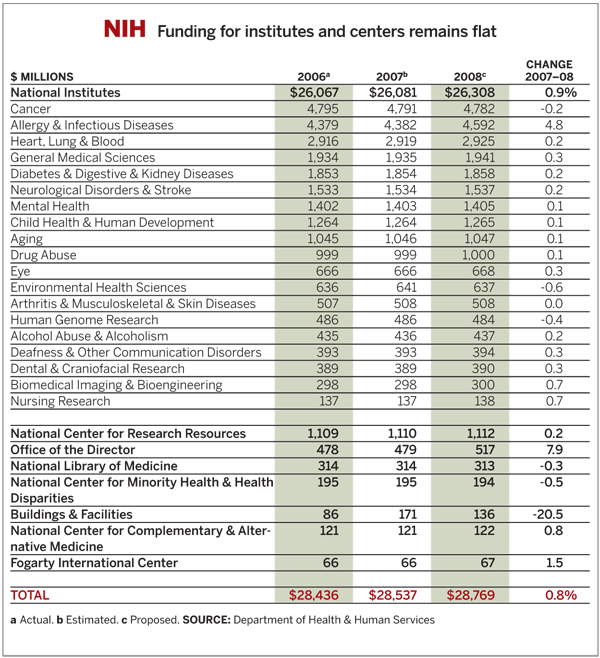

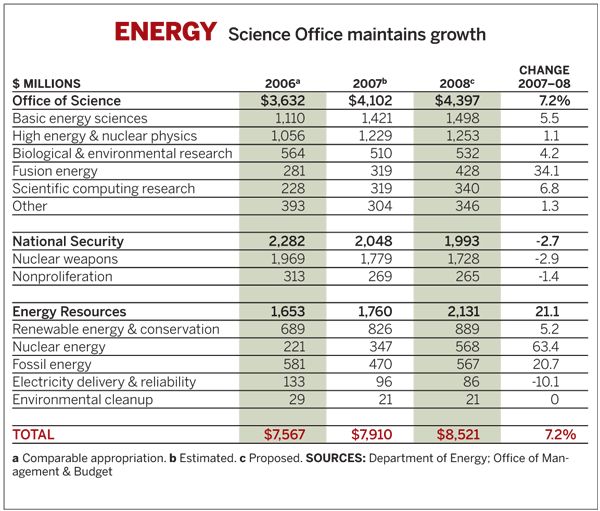
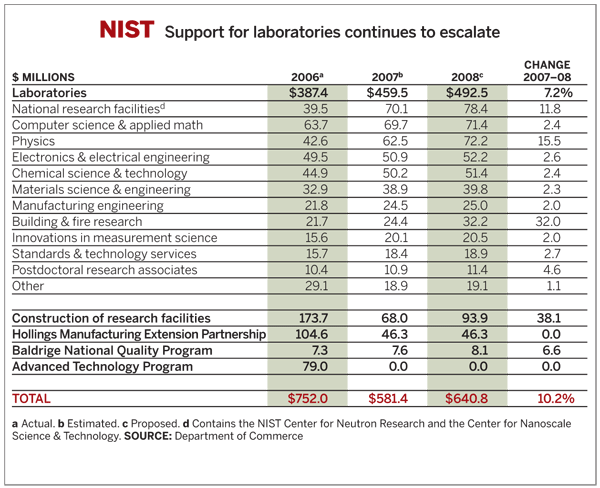

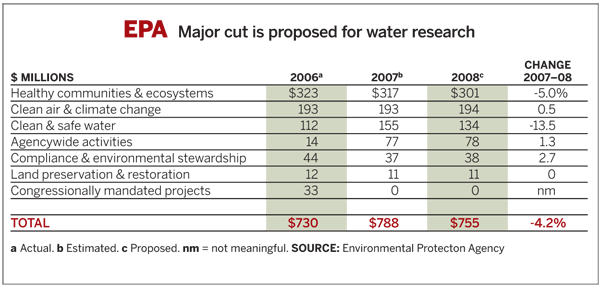


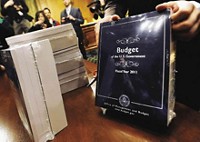

Join the conversation
Contact the reporter
Submit a Letter to the Editor for publication
Engage with us on Twitter